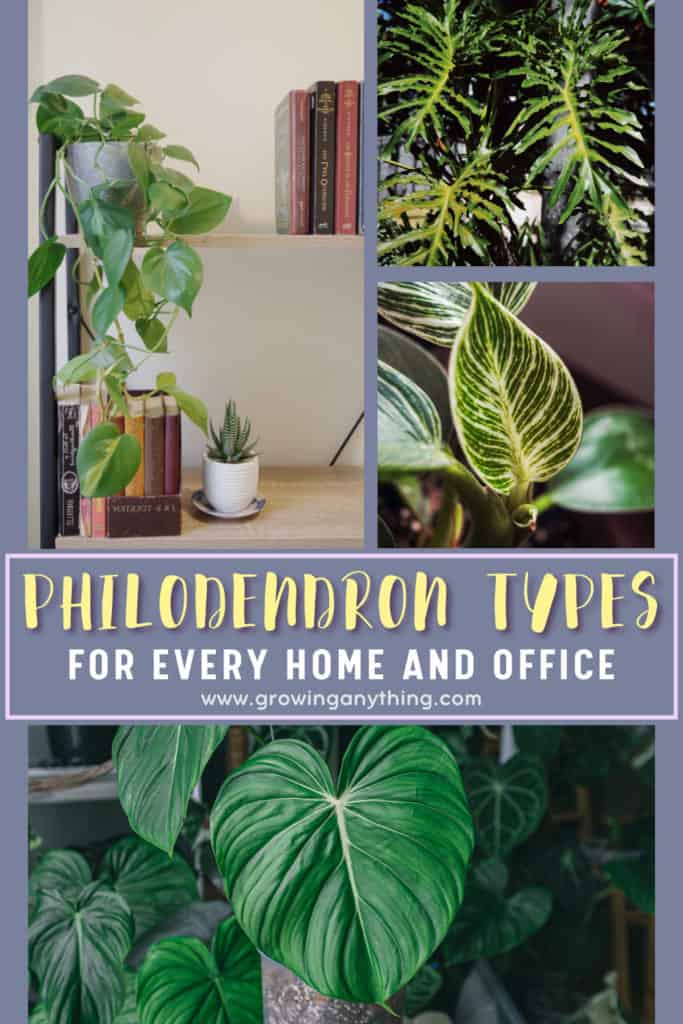51 Difference Types of Philodendron
There are so many Philodendron types to grow in your home. Philodendron is a low-maintenance, adaptable plant with high ornamental value. It is what makes Philodendron so popular!
Are you looking for a new plant to grace your home? Keep reading to find inspiration!
From everyday, easy-going varieties to rare ones, Philodendron has it all! Philodendron types differ mostly by their foliage and origin. Tropical plants are lush and rich and give a special vibe in every space.
Here is my selection of the best Philodendron types to grow!
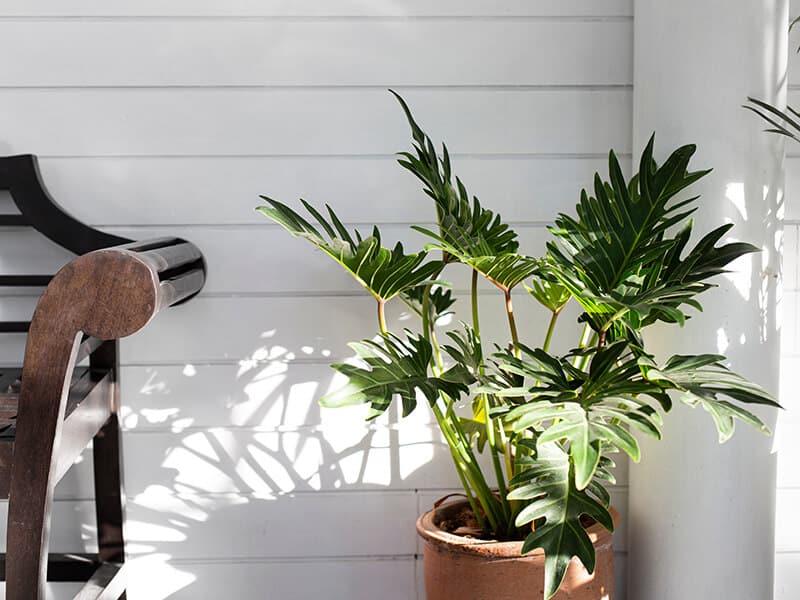
#1 Philodendron Lemon Lime
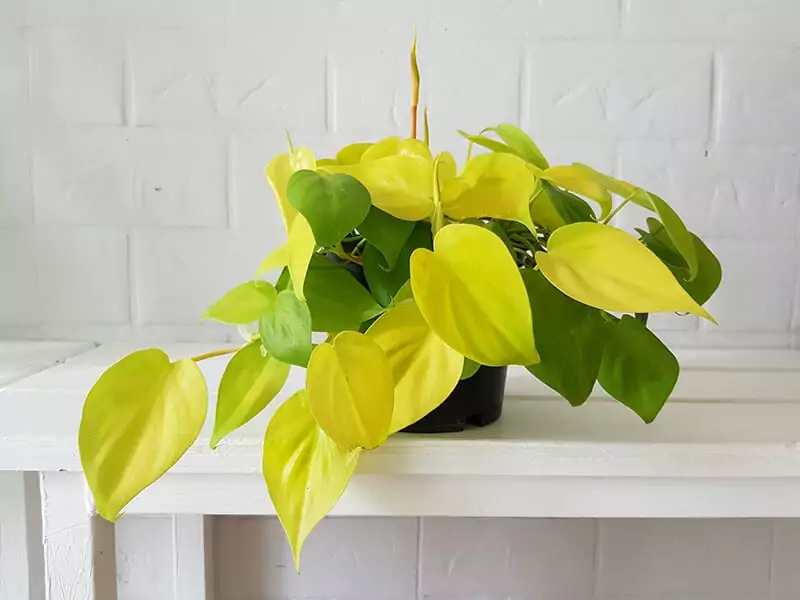
Philodendron hederaceum Lemon or simply Lemon Lime Philodendron features bright green, almost yellow foliage. The plant is easy to grow in well-draining and rich potting soil. You’ll also have to fertilize it during the growing season.
When it comes to water, Lemon Lime Philodendron is simple. Wait until the soil is dry to water the plant. The plant has a bushy growth habit, which you can enhance by regular pinching.
Read more tips on how to grow Philodendron Lemon Lime!
Take a closer look at Lemon Lime Philodendron. Watch the video below:
#2 Heartleaf Philodendron
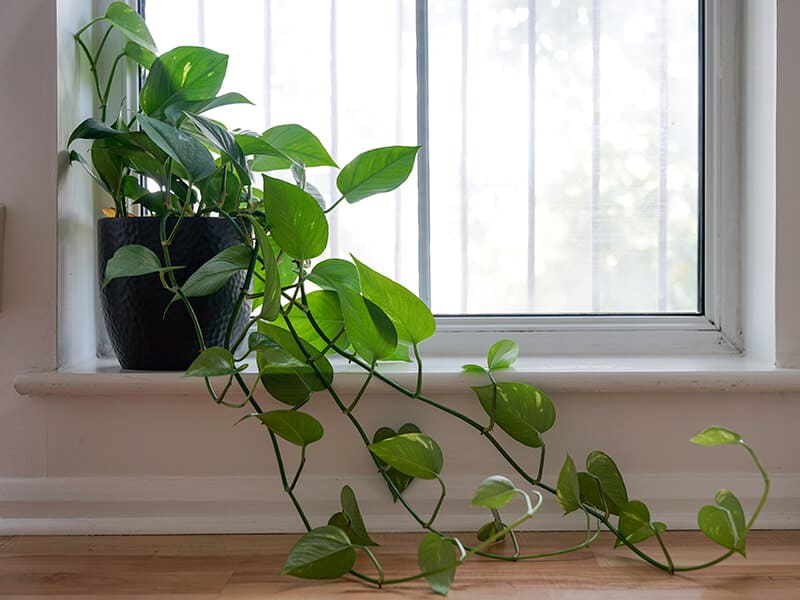
Philodendron Hederaceum or Heartleaf Philodendron is probably the most common variety of this plant. As the name suggests, it features leaves, shaped like hearts, and is sometimes called the Sweetheart plant. The leaves are glossy and thick and get dark green when the plant matures.
Here is more information on how to grow Heartleaf Philodendron.
#3 Philodendron Plowmanii
Philodendron Plowmanii is a rare variety of Philodendrons. The plant grows slowly and is known for its attractive, bi-colored foliage. It needs indirect sun and warm temperatures to grow.
Check out the best hacks to grow Philodendron plowmanii.
#4 Philodendron Verrucosum
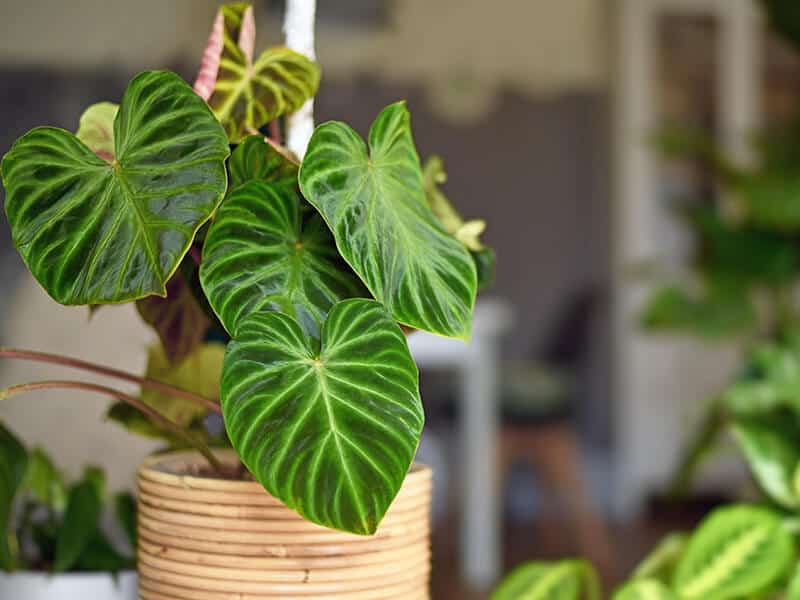
The tropical Philodendron verrucosum prefers high humidity and cold temperatures. It makes it a tricky plant to grow, but a very beautiful one.
You can make it thrive by regularly watering it and adjusting the humidity in your home to the setting over 70%. Verrucosum is a rare and expensive Philodendron, but worth your attention!
Read the complete maintenance guide for Philodendron Verrucosum!
#5 Philodendron Imperial Green
The Philodendron erubescens is better known by its common name – Imperial Green. The plant got the name Imperial due to its large and luscious leaves, in the deep shape of green. The leaves are fanned out in all directions and have high ornamental value.
Learn how to take care of the Imperial Green Philodendron.
#6 Philodendron Burle Marx
Philodendron mello-barretoanum or Burle Marx type features true-green glossy leaves. The plant is a vigorous climber that will quickly spread if you provide the right conditions for it. Indoors, Burle Marx gets around two feet tall, but in its native habitat, the plant gets significantly taller.
Learn what the best conditions for growing Burle Marx are!
Find out how good is Burle Marx as a houseplant. Watch this video:
#7 Silver Leaf Philodendron
Philodendron Brandtianum or Silver Leaf Philodendron is a tropical plant that has beautiful olive green leaves. The leaves have splashes of silver!
This type is bushy and is often used in hanging baskets. But, because it is a climber by nature, you can train the plant to use a trellis as support and grow upwards.
Find out how to take care of Silver Leaf Philodendron.
#8 Philodendron Pedatum
Philodendron Pedatum is sometimes called Oak Leaf Philodendron. If you have a low-light corner in your home, the Pedatum will be perfect! It doesn’t need complex care to award you with ornamental foliage.
The plant features deep green, multi-lobed leaves shaped like oaks, that develop on purple petioles!
Find out interesting information on Philodendron Pedatum.
#9 Horsehead Philodendron
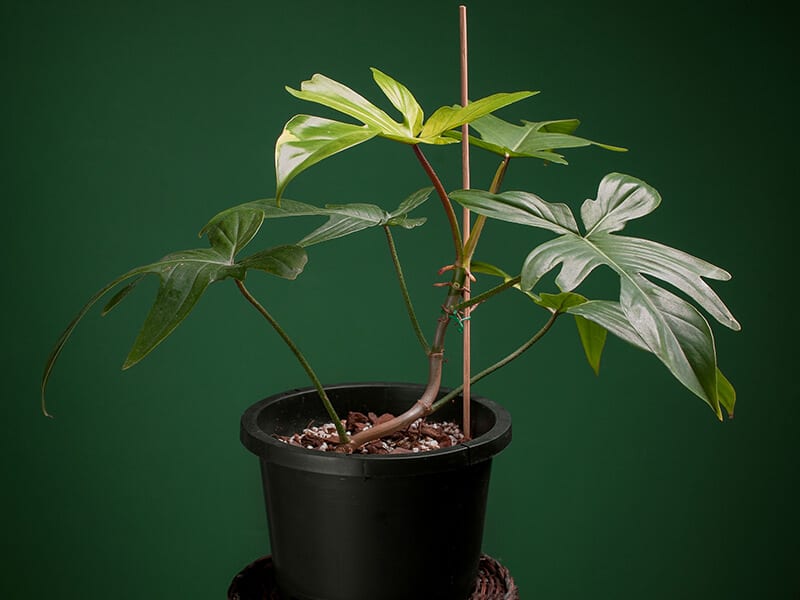
Philodendron Bipennifolium is better known as Horsehead Philodendron. The plant has wide leaves in the base and they will slowly become more narrow.
The plant is very easy to care for. It is adaptable to different conditions, but it grows best in indirect sunlight, moderate moisture, and a well-draining potting mix.
Is Horsehead Philodendron a strong climber? Click here to find out!
#10 Philodendron Prince of Orange
The Philodendron hybrid Prince of Orange is an attractive plant, easily recognizable by its foliage. The leaves transform from yellow, through the orange and dark green as the plant matures.
Generally, Prince of orange is a slow-grower and compact plant. However, it can reach two feet indoors when you take good care of it!
Read everything you need to know about Prince of Orange Philodendron!
Learn the best hacks for the Prince of Orange plant:
#11 Philodendron Brasil
If classical Philodendron seems plain to you, check out the colorful version – Brasil! The plant has a tropical vibe and lovely leaves in green and yellow, hence the name. The plant Brazil is a trailing plant, but you can prune it to keep the shape you want.
Find out how much light Philodendron Brazil needs to remain colorful.
#12 Philodendron Squamiferum
Philodendron Squamiferum is native to rainforests where it grows attached to nearby trees. Indoors, you can train it to grow on the trellis or fence you can easily build.
It is different from other Philodendron types by its stems. They are covered with fuzzy red hair!
The plant needs a humid environment and moderate light exposure.
Read more interesting facts about this Philodendron!
#13 Philodendron Camposportoanum
Philodendron Camposportoanum is your choice if you want a unique and compact plant. When the new leaves appear, they seem orange and slowly turn green as the plant matures. Also, the plant has different shaped leaves which gives it a unique look!
Is Camposportoanum a rare variety of Philodendron? Click here to find out!
#14 Philodendron Majesty
When exposed to bright light, Philodendron Majesty develops rich dark leaves with the royal vibe. The foliage texture is almost velvety!
The plant has high ornamental value, and you can grow it indoors in pots and hanging baskets and outdoors. But, only USDA hardiness zones 9b-11 are suitable for growing this Philodendron outdoors.
Read more about Majesty Philodendron plant care!
#15 Philodendron Xanadu
Xanadu Philodendron is known for its large and feathery foliage. Each leaf can have up to 15 and 20 lobes! The plant has a bushy growth habit and true green color when exposed to growing conditions.
Overall, Xanadu is a low-maintenance plant, suitable even for beginners.
Here is all you need to know about growing Xanadu Philodendron.
Get the complete plant care guide for Xanadu Philodendron:
#16 Philodendron Moonlight
Philodendron Moonlight features bright green, the neon color of the foliage. It is a cheerful plant that is one of the easiest Philodendrons to maintain.
Young growth is greenish with reddish glare. As the plant matures, the leaves become emerald green!
Read more about Philodendron Moonlight!
Check out the pest plant care for Philodendron Moonlight:
#17 Philodendron Micans
Philodendron hederaceum var. hederaceum or Philodendron Micans has large, velvety leaves. The leaves are dark-green with purple glare and slightly visible shimmer. This charming plant requires a bit of love and care to maintain the velvety texture.
Water the plant when the top inch level of soil becomes dry!
Learn what it takes to keep your Micans Philodendron healthy!
#18 Philodendron Patriciae
Philodendron Patriciae is an exotic Philodendron type, praised for its long and textured leaves. The plant enjoys high humidity but can adapt to different conditions.
Read more about the attractive Philodendron Patriciae!
#19 Philodendron Joepii
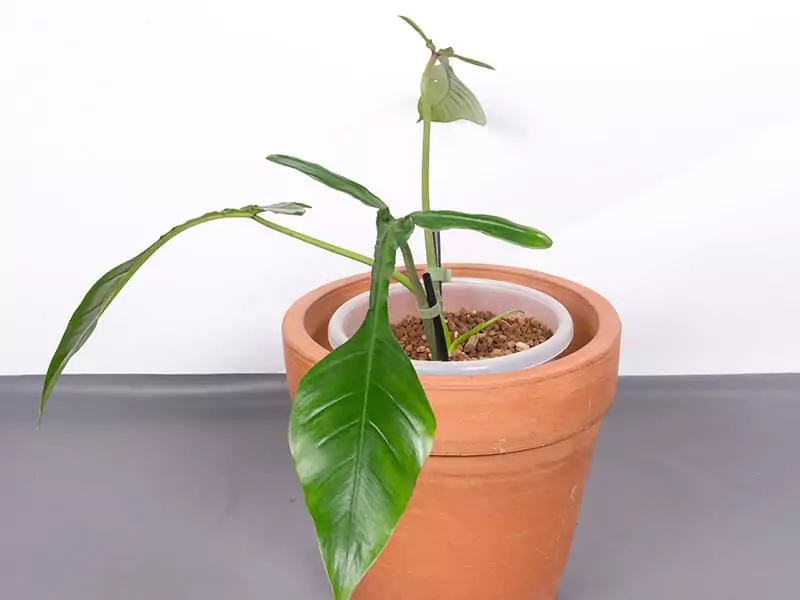
Philodendron Joepii is an expensive and rare plant. If you take good care of Joepii, the leaves might reach 27 inches in length! The plant is a vigorous climber but looks great in the hanging basket as well.
Check out the best tips for growing Joepii Philodendron!
#20 Philodendron Sharoniae
Philodendron Sharoniae is a tropical plant and a fast grower. It features long and narrow, green leaves. The ideal conditions for this Philodendron are indirect light, well-draining soil, and moderate temperatures!
Discover what makes the Sharoniae philodendron so special!
#21 Philodendron Paraiso Verde
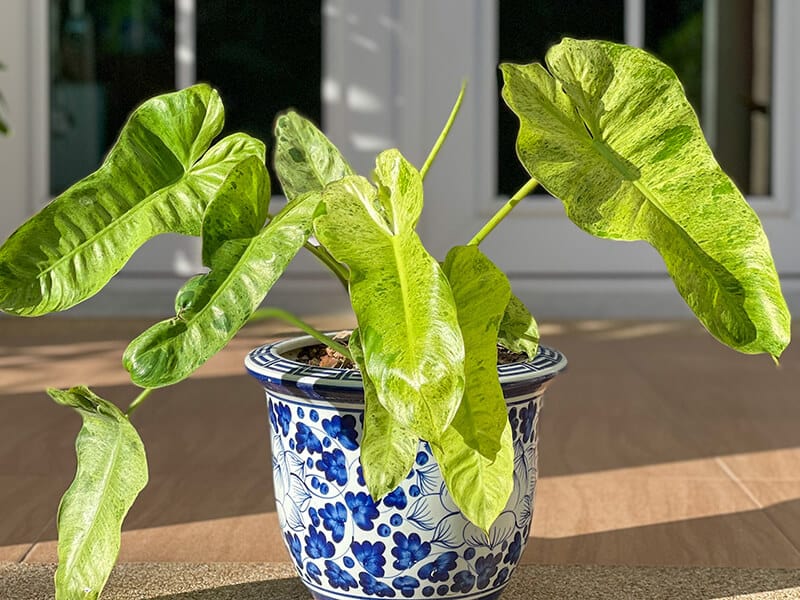
Philodendron Paraiso Verde is mostly grown for its foliage. The plant needs a lot of light to grow, but direct light will burn the leaves. Therefore, ensure that the plant is protected from direct light, and plant it in the potting soil with perlite.
Learn how to recognize Paraiso Verde Philodendron!
#22 Philodendron Jose Buono
Philodendron domesticum, Jose Buono, or Spade Leaf Philodendron has elongated leaves and dark stems. The plant is tropical and exotic, and the leaves are glossy and very long. You can find the variegated versions with multi-colored leaves for a more stunning effect!
Here is more information on Jose Buono Philodendron!
#23 Philodendron Bernardopazii
The Bernardopazii is a vigorous Philodendron type. In its native habitat, the plant easily spreads on the nearby leaves. Indoors, you can teach it to climb on the supporting structure, even the window.
The plant has thick and long leaves, with bright white veins. It is rare, but a beautiful variety of Philodendrons!
Read more about the origin of Philodendron Bernardopazii.
#24 Philodendron Melanoneuron
Philodendron Melanoneuron is a highly adaptable plant. You don’t have to think twice about the ideal location for your plant! Ensure it has some indirect light and that is all. The plant is not as popular as some other Philodendron varieties, but it is an interesting specimen!
Is Melanoneuron a climber? Find out now!
#25 Philodendron Tripartitum
Philodendron Tripartitum has leaves with three lobes. Each leaf can reach 12 inches in length when provided with optimal growing conditions. Moreover, the plant is a vigorous grower, perfect for growing on a totem or a tree.
If you a building a tropical indoor garden, the Tripartitum Philodendron might be your perfect addition!
Find out where does the Philodendron Tripartitum comes from!
#26 Philodendron Silver Sword
Philodendron hastatum or Silver Sword is a popular variety. The plant features lance-shaped foliage with pointy edges. It is a vine with a charming appearance, because of contrasting green leaves and silver hue.
Learn more interesting information on Silver Sword Philodendron!
#27 Philodendron White Knight
Philodendron White Knight is a rare and expensive variety of Philodendrons. It features bi-colored leaves.
One side of the leaf is dark green, and the other is bright white. The color variation on the foliage is almost symmetrical, which gives the plant an out-of-this-world appearance!
Here is what you need to know about proper care for Philodendron White Knight!
#28 Philodendron Pink Princess
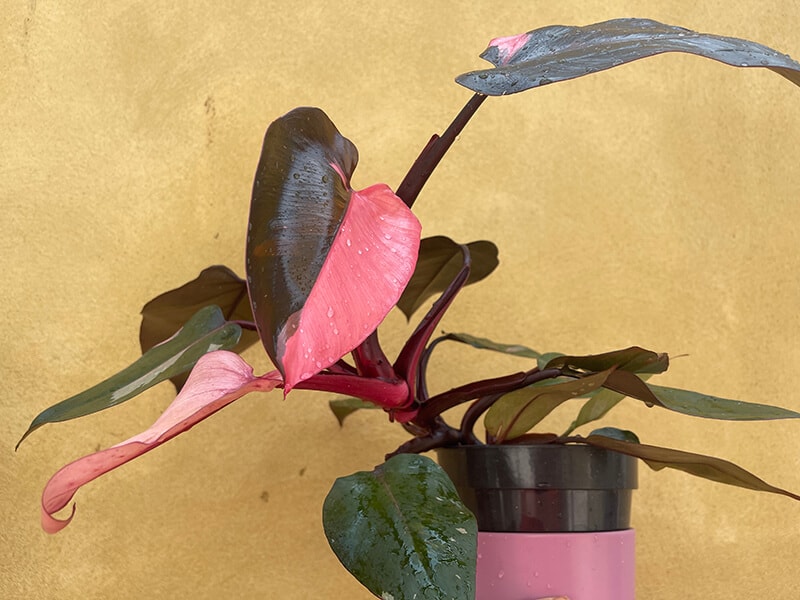
Pink Princess has attractive pink-green leaves. On top of everything, the foliage is thick and lush, and the plant develops different shades of pink, from pastel to hot pink.
The plant may get around two feet tall!
Read more about this amazing variety of Philodendrons!
#29 Philodendron Rugosum
Philodendron Rugosum is suitable for partial sun locations. It is endemic species in Ecuador.
The plant has distinct leaves with round edges and grass-green shade. Overall, it is a low-maintenance plant, adaptable to different conditions. Just ensure that you don’t overwater it, because it may kill the plant.
Find out more facts about this unique-looking Philodendron!
#30 Philodendron Tortum
Philodendron Bipinnatifidum is also called Tortum or Lace Philodendron. The plant has unique foliage, rarely seen on the Philodendron species.
The foliage is thin and lace-shaped.
In warmer climates, the Lace Philodendron is grown outdoors for landscaping purposes.
Learn more about this elegant plant!
#31 Philodendron Selloum
Philodendron Selloum is known as Tree Philodendron in its native area. It has huge leaves and aerial roots. When you grow it as a houseplant, ensure it gets moist soil and indirect site. A trick you can use is distilled water for irrigation because the plant is sensitive to salt!
Here is more information to know about Selloum Philodendron!
#32 Philodendron Grazielae
The Grazielae is such a lovely type of Philodendron. The plant is fuss-free and has beautiful, heart-shaped leaves, thick and glossy. All it takes to keep the plant healthy is indirect sun and moderate watering.
Find out more about the cute Philodendron Grazielae!
#33 Philodendron Brandtianum
Philodendron Brandtianum or Brandi Philodendron features olive green foliage with silverish splotches of color. This tropical plant is attractive when planted in the hanging basket. You can also teach the plant to grow on the trellis!
Does Brandi Philodendron have air-purifying properties? Click here to find out!
#34 Philodendron Ring of Fire
The Ring of Fire Philodendron isn’t something you will easily find in your local nursery. This one is an expensive and rare variety. It looks attractive with its leaves that resemble the handsaw teeth. Moreover, the leaves are variegated and a mixture of grass green and yellow!
Is Ring of Fire a great plant for your collection? Find out now!
#35 Philodendron Callosum
Philodendron Callosum is native to Venezuela and a rare plant to find. It features long and flat, fleshy leaves in the dark green shade.
The leaves are rigid and have an almost leathery texture. It can grow as a creeping plant or in the hanging basket!
Read more about this unique plant!
#36 Philodendron Pastazanum
Philodendron Pastazanum is a unique variety of Philodendrons. The plant is a creeper, with its rhizome growing above the soil. But, it is best recognizable by its large heart-shaped leaves with textured veins.
Find out what makes the Pastazanum Philodendron different from other Philodendron types!
#37 Philodendron Atabapoense
Philodendron Atabapoense is one of the rarest Philodendrons out there. The plant features massive leaves, long and narrow. It is suitable for almost all indoor conditions, as long as there is little indirect light. It is also an air-purifying plant!
How tall can Atabapoense get? Click here to discover!
#38 Philodendron Congo Rojo
Philodendron Congo Rojo loves warm weather. It is known for its showy flowers and distinct foliage.
The leaves are dark green on the outer side and burgundy red on the underside!
It is a low-maintenance plant, suitable for all rooms!
Read a quick growing guide for Congo Rojo Philodendron.
Tips to grow the tallest Congo Rojo indoors fast. Watch this video below:
#39 Philodendron Billietiae
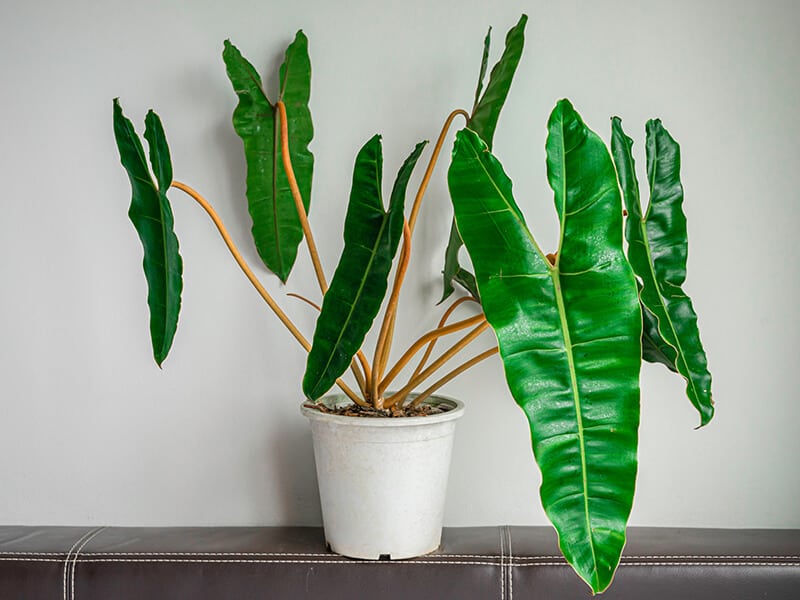
Philodendron Billietiae has large leaves and an upright growing habit. It needs a bit of maintenance until established, but then it becomes a low-maintenance plant. You can place it near the sunny window and turn it occasionally to encourage even growth!
Learn how to recreate the conditions found in the natural habitat of Philodendron Billietiae.
#40 Philodendron Green Congo
Green Congo Philodendron doesn’t need as much water as other types. Because it has aerial roots, you can harm the plant if you overwater it. It can reach about feet in height when grown indoors. In its native area, the plant gets significantly taller!
Discover the reason number one for yellow Philodendron leaves!
#41 Philodendron Subhastatum
The Subhastatum Philodendron thrives in indirect sunlight and medium indoor temperatures. But, the plant needs high humidity and moisture to establish. You can mist the plant or place it in your bathroom to improve its growth.
Next, fertilization is needed, weekly, mostly in the growing season.
Is Subhastatum a climber? Read more information and find out!
#42 Philodendron Mexicanum
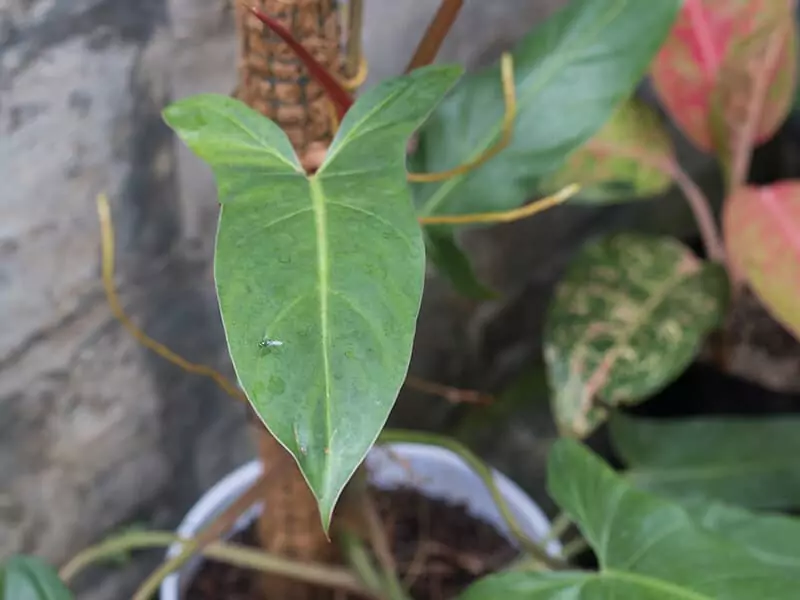
Mexicanum Philodendron needs a lot of sunlight. But, ensure the sun is filtered to prevent it from burning the foliage. The plant is native to tropical rainforests so it also enjoys high humidity. Regular misting may help overcome dry air!
Can you identify Philodendron Mexicanum? Check out more distinctive features of the plant!
#43 Philodendron Birkin
Philodendron Birkin is an elegant and attractive houseplant. It exists because of the rare mutation, which gave the plant its lovely ornamental leaves.
The dark green foliage has creamy white, almost yellow veining. The plant doesn’t need a lot of sunlight per day to thrive!
Find out how much water Birkin Philodendron needs.
#44 Philodendron Painted Lady
The Painted Lady plant is a cheerful plant with bright green and yellow foliage. New growth develops as bright neon yellow and slowly fades to green as the Philodendron matures.
Discover how rare the Painted Lady Philodendron is.
#45 Toothed Philodendron
Philodendron lacerum or Toothed Philodendron is a vigorous climber. Therefore, you’ll have to provide the plant with a stalk or any kind of supporting structure. The plant needs soil with high content of bark and charcoal.
Get more growing tips for Toothed Philodendron!
#46 Flask Philodendron
Philodendron martianum is better known as Pacová, or Flask Philodendron. The plant comes from Brazil and develops beautiful clusters of small, narrow but long leaves. As a houseplant, Pacová is low-maintenance and rewarding. It has great air-purifying properties!
Find out if Pacová is a pet-friendly plant!
#47 Blotched Philodendron
Philodendron Mamei or Blotched Philodendron is a rare and unique specimen. It is known among plant collectors for its shiny leaves. The established plant is expensive but worth investing in because it can last for years and decorate every room!
Learn more about the Blotched Philodendron.
#48 Philodendron Bob Cee
Bob Cee is a large plant that develops saw-toothed-shaped leaves with exceptional glossiness. The plant is tropical and lush, and instantly transforms every space! Bob Cee isn’t a very popular Philodendron plant, but it is an excellent choice for collectors.
Read the guide on propagating your Phill plants!
#49 Philodendron Melanochrysum
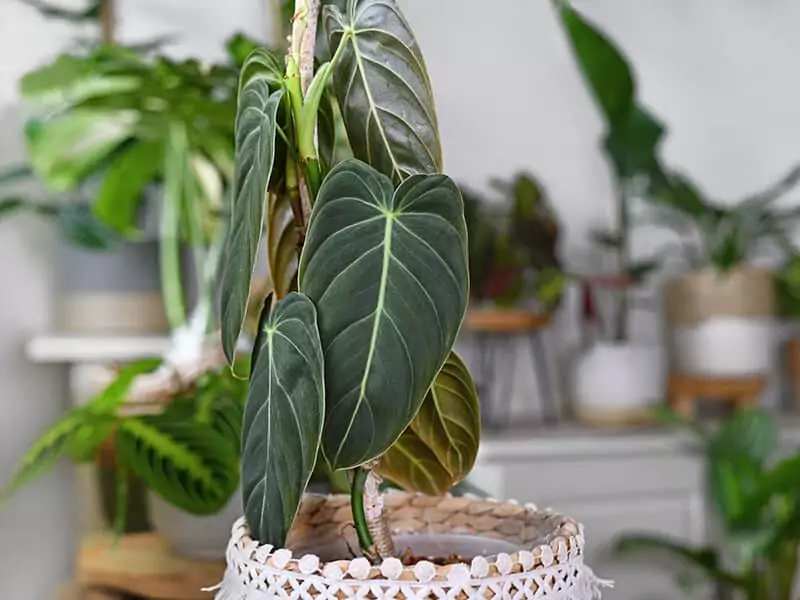
The Melanochrysum needs bright filtered light to thrive. You’ll also have to ensure the soil remains moist but not soggy. Considering that the plant comes from tropical areas, it is understandable that it enjoys high humidity and warmer conditions.
You can provide the plant with a pole to train it to grow upwards!
Here is a quick overview of the most important growing tips for Philodendron Melanochrysum.
#50 Philodendron Mayoi
The Mayoi is an unjustly neglected variety of Philodendron. The plant has palm-like foliage, which gives it an ornamental and tropical vibe. Mayoi is suitable for both experienced gardeners and beginners! It is a low-maintenance plant that can adapt to various conditions.
How do you propagate Mayoi Philodendron? Find out here.
#51 Philodendron Thai Sunrise
Thai Sunrise is a collectors-favorite because of its unique leaves and yellow stems. Each leaf can become seven to ten inches long and develop a lime green variegation pattern. The maximum height Thai Sunrise can reach indoors is around three feet.
Find out how often you need to fertilize your Thai Sunrise plant!
Philodendron Types – If You Grow Them All…
If you have made it through the list, congratulations! There are so many Philodendron varieties to choose from, so it’s difficult to pick only one. Also, Philodendron has always been collectors’ favorite plant! If you can get your hands on some rare types, don’t miss a chance to improve your plant collection!
My favorite types are Birkin and Silver Sword. What about you? Which one will you choose for your home?
If you know about additional Philodendron types, please mention them in the comment section below! Come back for more gardening articles!
